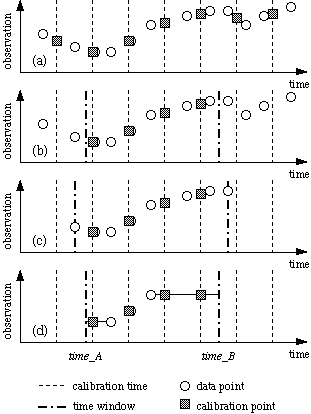Syntax
>>>> WINDOW (INDIVIDUAL / : time_A time_B (time_unit))
Parent Command
all third-level commands in block > OBSERVATION
Subcommand
-
Description
The times at which the observed and calculated system response are compared are referred to as calibration times. They are specified using command >> TIME. The calibration times are defined globally, i.e., there is only one set of calibration times and it is applied to all data sets. Calibration times and observation times may be different; observed data are linearly interpolated between adjacent data points to obtain a value at the calibration time. In the standard case, the first data point is observed at or before the first calibration time, and the last data point is observed at or after the last calibration time. This configuration ensures that a value for calibration is available or can be interpolated at every calibration point.
The standard situation is sketched in Figure (a) below, assuming that equally spaced calibration times (dashed lines) have been defined. If, for some reason, only a subset of the available data can be used for calibration as shown in Figure (b), the user must specify the time window between which data should be processed:
time_A and time_B are the lower and upper bounds of the window. Only one time window may be specified per data set. If more than one time window is required, new data sets containing the same data must be generated and different time windows specified for each data set (see keyword INDIVIDUAL for an alternative option).
The time units of time_A and time_B can be specified using one of the time_unit keywords.
If a data set does not contain data that extend over the entire range of calibration times, iTOUGH2 automatically adjusts the time window to coincide with the first and last data point as shown in Figure (c). A warning message is printed, however, which can be avoided by explicitly specify the time window. If the specified time window is larger than the available data set, the value of the first and last data point is horizontally extrapolated to time_A and time_B, respectively, as indicated in Figure (d).
If keyword INDIVIDUAL is present, individual time windows will be set around each data point, and the observation times will be automatically added to the vector of calibration times. No time_A and time_B need to be specified in this case.
If time is shifted, the time window must be given with reference to the time system of the data, if command >>>> SHIFT TIME: tshift appears before command >>>> WINDOW. Conversely, the window must be given in the shifted time system, if the shift command appears after command >>>> WINDOW.
 Example
Example
> OBSERVATION
>> :7 EQUALLY spaced TIMES in [MINUTES]
5.0 35.0
>> PRESSURE
>>> ELEMENT: ZZZ99
>>>> DATA [HOURS] on FILE: pres.dat
>>>> time WINDOW: 299.0 901.0 [SECONDS] -> 3 calibration points
>>>> DEVIATION : 1.E3
<<<<
<<<
See Also
>> TIME | >>>> SHIFT